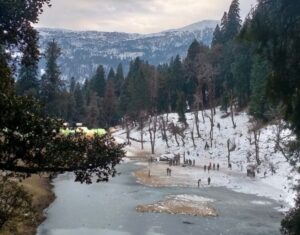Uttarakhand, nestled in the lap of the Himalayas, is a paradise for trekkers. From snow-clad peaks to lush alpine meadows, every trail here has its own story to tell. Whether you are conquering the icy summit of Kedarkantha or soaking in the serene beauty of the Valley of Flowers, each trek challenges your spirit and rewards you with memories that last a lifetime. But the key to enjoying these adventures lies in preparation, awareness, and respect for nature.

Here are some essential trekking tips tailored to every type of trail in Uttarakhand — from the easy to the extreme.
1. Understand the Terrain Before You Go
Each trek in Uttarakhand has a unique landscape. Kedarkantha Trek, for example, takes you through pine forests and snow-laden meadows before opening up to breathtaking 360-degree views of Himalayan peaks. In contrast, the Valley of Flowers trek is a monsoon delight — filled with vibrant blossoms, waterfalls, and misty trails.
Before starting any trek, study the route map, altitude profile, and weather conditions. Knowing the trail helps you plan your pace, manage expectations, and pack the right gear for comfort and safety.
2. Train for Endurance and Strength
No matter how scenic the route, trekking in Uttarakhand requires physical fitness. Some trails like Nag Tibba are beginner-friendly, while others such as Roopkund or Rupin Pass demand stamina and altitude adaptability.
Focus on cardio training, leg strength, and core stability at least a month before your trek. Jogging, stair climbing, cycling, and brisk walking can improve endurance. Practicing hikes with a loaded backpack also helps simulate real conditions.
Remember — it’s not just about reaching the summit but doing it safely and joyfully.
3. Pack Smart, Travel Light
Packing for a Himalayan trek is all about balance — carrying enough essentials without overburdening yourself.
Here’s a quick checklist:
- A sturdy backpack with a rain cover
- Layered clothing (thermal, fleece, and waterproof jacket)
- Trekking shoes with strong grip
- Reusable water bottle, dry fruits, and energy bars
- Trekking poles, gloves, and a headlamp
- Basic first-aid kit, sunscreen, and lip balm
Avoid unnecessary gadgets or extra clothes. Lighter loads help you trek longer without fatigue.
4. Respect Altitude and Acclimatize Gradually
Altitude sickness is one of the biggest challenges in Himalayan treks. Trails like Har Ki Dun or Kedarkantha can reach heights above 10,000 ft, where oxygen levels drop.
- To avoid Acute Mountain Sickness (AMS):
- Ascend gradually — don’t rush your climb.
- Stay hydrated, but avoid overconsumption of water.
- Skip alcohol and smoking during the trek.
- Recognize early symptoms — headache, nausea, or dizziness.
A responsible trekking company will schedule acclimatization days in the itinerary. Take them seriously; they can make the difference between finishing your trek or turning back early.
5. Choose the Right Time to Trek
Timing can make or break your trekking experience.
- Kedarkantha Trek: Best from December to April, when the snow transforms the landscape into a winter wonderland.
- Valley of Flowers: Perfect between July and September, when the monsoon awakens thousands of rare Himalayan blooms.
- Har Ki Dun: Ideal in spring and summer (March–June) for clear skies and green valleys.
Always check the local weather forecast. Sudden rain or snow can alter trails, affect visibility, and increase difficulty levels.
6. Go Eco-Friendly – Leave No Trace
The Himalayas are fragile. Every trekker plays a role in preserving their purity.
Follow these eco-conscious rules:
- Carry reusable utensils and water bottles.
- Avoid plastic wrappers; bring them back if you carry any.
- Use biodegradable soap and wet wipes.
Never pluck flowers in protected areas like the Valley of Flowers National Park.
Even one careless act — like leaving trash behind — can disrupt this delicate ecosystem. Responsible trekking is the only way to ensure future generations enjoy the same unspoiled beauty.
7. Hydrate and Eat Mindfully
Water is your best friend during a trek. High altitudes can dehydrate you faster than usual, so sip water regularly instead of gulping large amounts occasionally.
Eat light but energy-rich meals — local food like dal, rice, and chapati provides the right balance of carbs and proteins. Avoid overeating or trying unfamiliar dishes that may upset your stomach mid-trek.
If your trek is organized, ensure the operator provides nutritious and hygienic meals. A well-fed trekker is always a happy trekker!
8. Learn to Layer for the Himalayas
Temperatures in Uttarakhand can swing drastically — warm mornings can turn into freezing nights. Mastering the art of layering keeps you adaptable.
A practical formula:
- Base layer: Wicks sweat and keeps skin dry.
- Insulation layer: Retains body heat.
- Outer shell: Protects from wind, rain, and snow.
Carry extra socks and gloves — dry gear can literally save your trek when the weather turns harsh.
9. Be Mentally Prepared for the Unexpected
No matter how perfectly you plan, the mountains have their own rhythm. Landslides, weather changes, or altitude fatigue can alter your schedule.
Stay positive, flexible, and patient. Sometimes the best experiences happen when things don’t go as planned — like witnessing an unexpected sunrise after a night storm.
A calm, adaptive mindset is as vital as your physical readiness.
10. Travel with a Reliable Trekking Company
Choosing the right trekking operator can make your entire journey seamless. A good company ensures safety, guides with local expertise, quality gear, and proper planning for every trekker’s needs.
Before booking, verify that the company:
- Has experienced, certified trek leaders
- Uses eco-friendly practices
- Maintains transparent itineraries and safety protocols
- Provides well-maintained equipment
Conclusion: Trust Experience, Safety, and Sustainability
Uttarakhand’s treks — from the snowy Kedarkantha to the flower-laden Valley of Flowers — offer something for every kind of adventurer. But to truly enjoy these trails, you need the right guidance, preparation, and care.
For those looking to explore the Himalayas responsibly, choosing the Best trekking company in Uttarakhand is essential. Himalaya Tribe stands out for its expert-guided tours, commitment to eco-friendly practices, and focus on safety. Whether you’re a beginner or a seasoned trekker, Himalaya Tribe ensures every step you take in the Himalayas is filled with confidence, comfort, and unforgettable memories.





